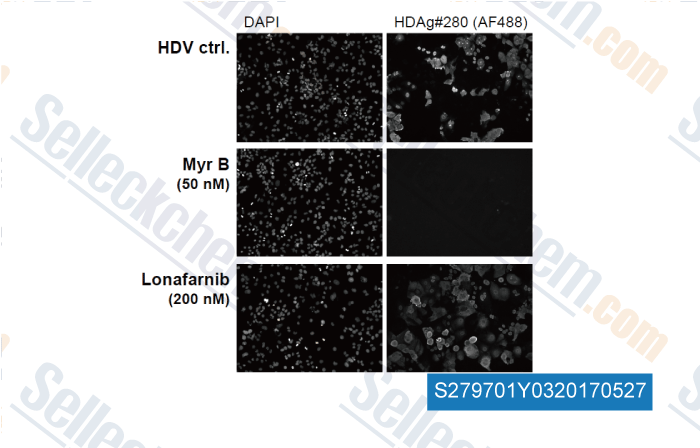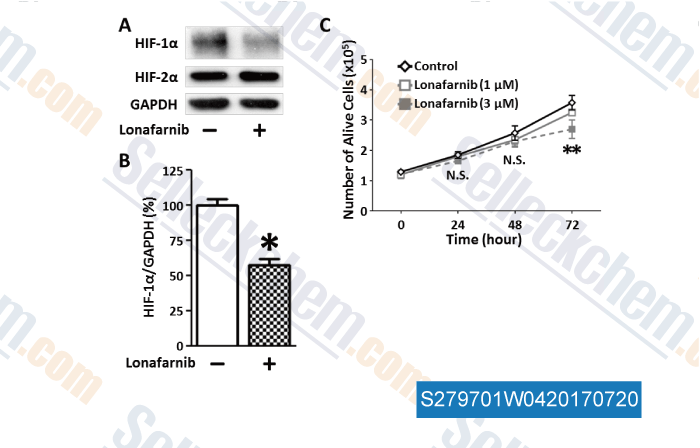|
Toll Free: (877) 796-6397 -- USA and Canada only -- |
Fax: +1-832-582-8590 Orders: +1-832-582-8158 |
Tech Support: +1-832-582-8158 Ext:3 Please provide your Order Number in the email. |
Technical Data
| Formula | C27H31Br2ClN4O2 |
|||
| Molecular Weight | 638.82 | CAS No. | 193275-84-2 | |
| Solubility (25°C)* | In vitro | DMSO | 11 mg/mL (17.21 mM) | |
| Water | Insoluble | |||
| Ethanol | Insoluble | |||
|
* <1 mg/ml means slightly soluble or insoluble. * Please note that Selleck tests the solubility of all compounds in-house, and the actual solubility may differ slightly from published values. This is normal and is due to slight batch-to-batch variations. * Room temperature shipping (Stability testing shows this product can be shipped without any cooling measures.) |
||||
Preparing Stock Solutions
Biological Activity
| Description | Lonafarnib (SCH66336) is an orally bioavailable FPTase inhibitor for H-ras, K-ras-4B and N-ras with IC50 of 1.9 nM, 5.2 nM and 2.8 nM in cell-free assays, respectively. Phase 3. | ||||||
|---|---|---|---|---|---|---|---|
| Targets |
|
||||||
| In vitro | SCH66336 at concentration ranging from 0.1 μM to 8 μM suppress growth and induce apoptosis of human head and neck squamous carcinoma cells (HNSCC) in a dose and time dependent manner. SCH66336 (8 μM) suppresses protein kinase B/Akt activity as well as the phosphorylation of the Akt substrates glycogen synthase kinase (GSK)-3β, forkhead transcription factor, and BAD in SqCC/Y1 cells. [2] SCH66336 demonstrate variable antiproliferative effects against the cell lines, with IC50 ranging from 0.6 μM to 32.3 μM. [3] Lonafarnib induces a CCAAT/enhancer-binding protein homologous protein (CHOP)-dependent transactivation of the DR5 promoter, thus induces CHOP-dependent DR5 up-regulation. Lonafarnib (< 10 μM) activates caspase-8 and its downstream caspases, thus induces caspase-8-dependent apoptosis in H1792 cells. Lonafarnib (5 μM) up-regulate DR5 expression, increase cell-surface DR5 distribution, and enhance tumor necrosis factor-related apoptosis-inducing ligand-induced apoptosis in H1792 cells.[4] | ||||||
| In vivo | SCH66336 inhibits HTBI77 human lung carcinoma xenograft growth in nude mice in a dose-dependent fashion. [1] SCH66336 dosed at 50 mg/kg p.o. bid by oral gavage inhibits tumor growth with up to 69% growth inhibition after 21 days of treatment in NOD/SCID mice bearing s.c. flank XEN01, XEN05 or XEN08 GBM xenografts. [3] |
Protocol (from reference)
| Cell Assay:[2] |
|
|---|---|
| Animal Study:[3] |
|
References
Customer Product Validation

-
Data from [Data independently produced by , , Antiviral Res, 2017, 141:116-123]

-
Data from [Data independently produced by , , J Cell Physiol, 2017, 232(1):192-201]
Selleck's Lonafarnib (SCH66336) has been cited by 24 publications
| Functional-proteomics-based investigation of the cellular response to farnesyltransferase inhibition in lung cancer [ iScience, 2025, 28(2):111864] | PubMed: 39995872 |
| A farnesyl-dependent structural role for CENP-E in expansion of the fibrous corona [ J Cell Biol, 2024, 223(1)e202303007] | PubMed: 37934467 |
| A farnesyl-dependent structural role for CENP-E in expansion of the fibrous corona [ J Cell Biol, 2024, 223(1)e202303007] | PubMed: 37934467 |
| An hepatitis B and D virus infection model using human pluripotent stem cell-derived hepatocytes [ EMBO Rep, 2024, 25(10):4311-4336] | PubMed: 39232200 |
| African swine fever virus pB318L, a trans-geranylgeranyl-diphosphate synthase, negatively regulates cGAS-STING and IFNAR-JAK-STAT signaling pathways [ PLoS Pathog, 2024, 20(4):e1012136] | PubMed: 38620034 |
| Microtubule nucleation from the fibrous corona by LIC1-pericentrin promotes chromosome congression [ Curr Biol, 2023, S0960-9822(23)00010-6] | PubMed: 36720222 |
| Impact of a conserved N-terminal proline-rich region of the α-subunit of CAAX-prenyltransferases on their enzyme properties [ Cell Commun Signal, 2022, 20(1):118] | PubMed: 35941619 |
| A farnesyltransferase inhibitor restores cognitive deficits in Tsc2+/- mice through inhibition of Rheb1 [ J Neurosci, 2022, JN-RM-0449-21] | PubMed: 35121635 |
| Bacteria Are New Targets for Inhibitors of Human Farnesyltransferase [ Front Microbiol, 2021, 12:628283] | PubMed: 34917041 |
| Growth Factor Receptor Signaling Inhibition Prevents SARS-CoV-2 Replication [ Mol Cell, 2020, 80(1):164-174.e4] | PubMed: 32877642 |
RETURN POLICY
Selleck Chemical’s Unconditional Return Policy ensures a smooth online shopping experience for our customers. If you are in any way unsatisfied with your purchase, you may return any item(s) within 7 days of receiving it. In the event of product quality issues, either protocol related or product related problems, you may return any item(s) within 365 days from the original purchase date. Please follow the instructions below when returning products.
SHIPPING AND STORAGE
Selleck products are transported at room temperature. If you receive the product at room temperature, please rest assured, the Selleck Quality Inspection Department has conducted experiments to verify that the normal temperature placement of one month will not affect the biological activity of powder products. After collecting, please store the product according to the requirements described in the datasheet. Most Selleck products are stable under the recommended conditions.
NOT FOR HUMAN, VETERINARY DIAGNOSTIC OR THERAPEUTIC USE.
